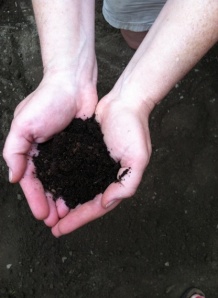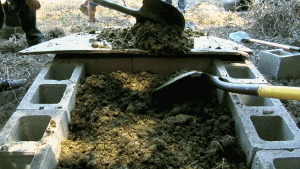Missey Harrison’s long ponytail was always getting in the wrong places. Just yesterday she was trimming veggie starts in her micro garden behind her parent’s house on Euclid Ave and her tail got really dirty between the rows. She has burned the thing in the biochar oven more times than she can recall.
“Anything for the movement, she yells (to no one)!”
Her new soil lab includes a series of small neighborhood supported compost piles, drying racks made from recycled pallets, a tool shed, and her father’s old banker’s desk where she packs her magic for global shipment. She learned about soil chemistry from her permaculture PDC; Harrison is now a globally-recognized biochar activist and alchemist. She ships seed balls via FedEx.
* * * * * * *
On her web site, the biochar burn is explained as:
BioChar is simply charcoal that is intended to go into the soil where it has some amazing benefits for soil and the environment. Charcoal is the carbon-rich material made from heating wood or other plant material in an oxygen-deprived atmosphere. As a soil additive, BioChar offers numerous potential benefits. It increases the capacity for soil to hold nutrients, enhances crop yields and captures and stores carbon for the long term. Unused biomass such as farm residues, green waste and sawmill scraps is heated with no or little oxygen present in a BioChar oven where the temperature can reach 1000F. The biochar-heating process releases energy-rich gases and preserves the char which can be ground up and mixed into soil to increase its fertility. And there’s money to be made from the process. A ton of BioChar could retail for $2000 or even more if packaged for specialty uses such as growing orchids or pot plants!
This is not about buying huge plantations or taking over natural forests; this is about using waste biomass and turning it into viable end products which then help the soil, help our food productivity, help with the climate problem and bring environmental, social and economic benefits. Biochar can greatly reduce the amount of water and fertilizers needed as well as making healthier, stronger more nutritious plants and vegetables.
* * * * * * *
Harrison’s Production Cycle is as follows:
Food Waste Materials Collected / Separated >
Heated in biochar Oven >
Produces Enriched Charcoal Soil Additive >
Biochar is mixed with available soil and organic materials in the compost pile >
Producing Super Soil > Hybrid, drought tolerant food crop seeds are then formed into 4” diameter balls with biochar >
Seed balls (one part BioChar, one part super soil, one part seed ball) are shipped across the Planet.


